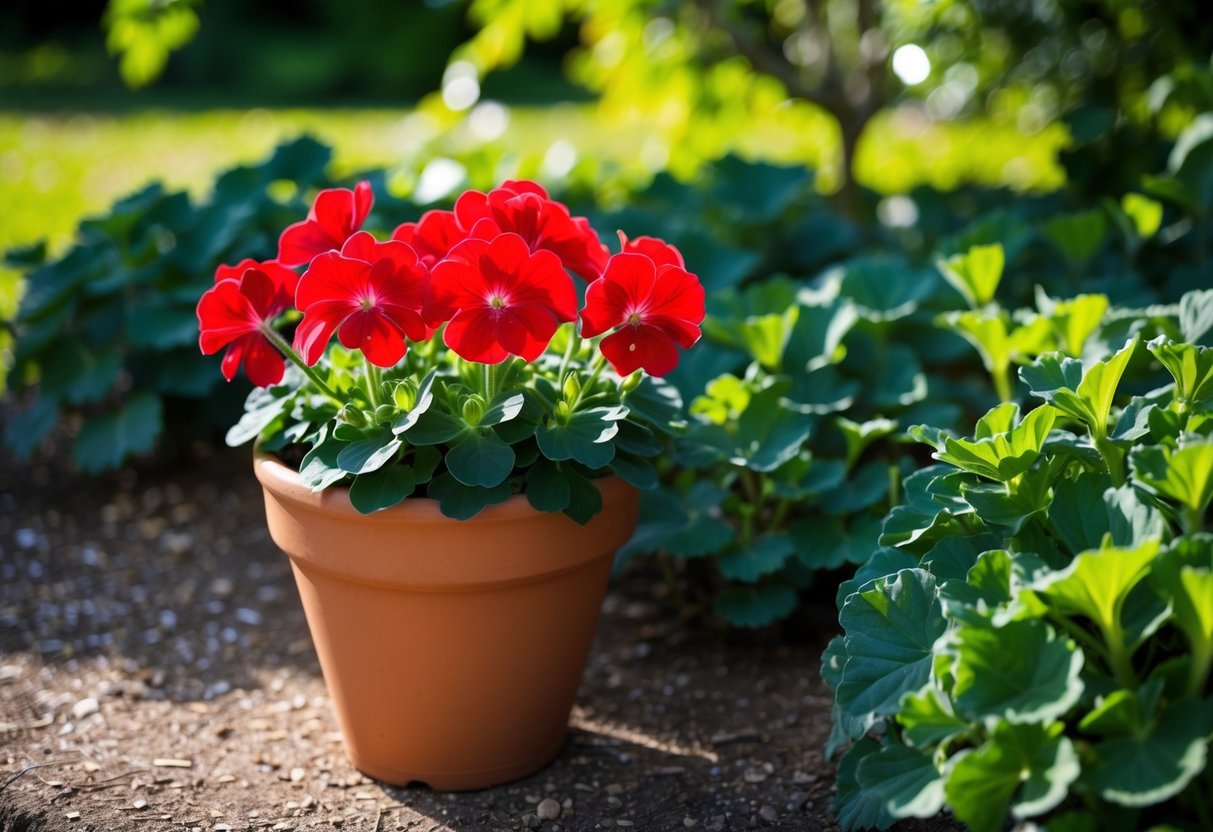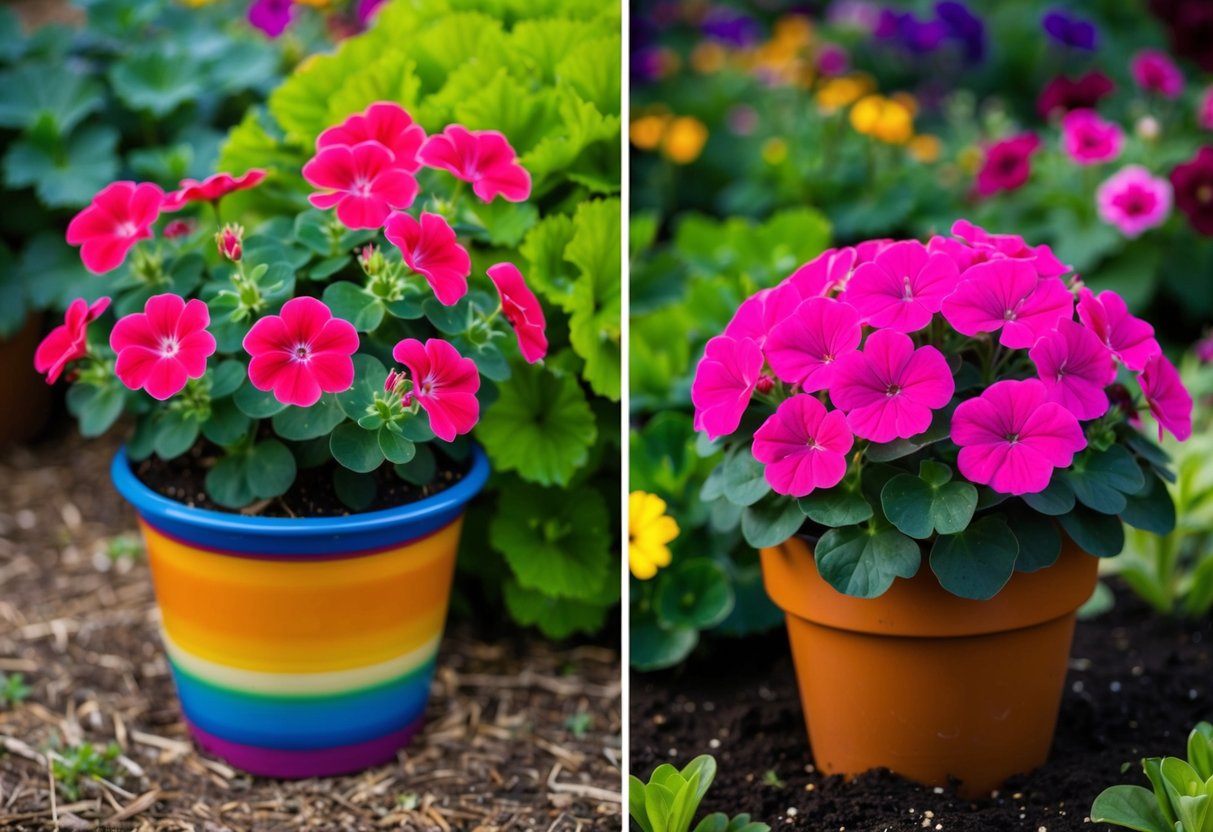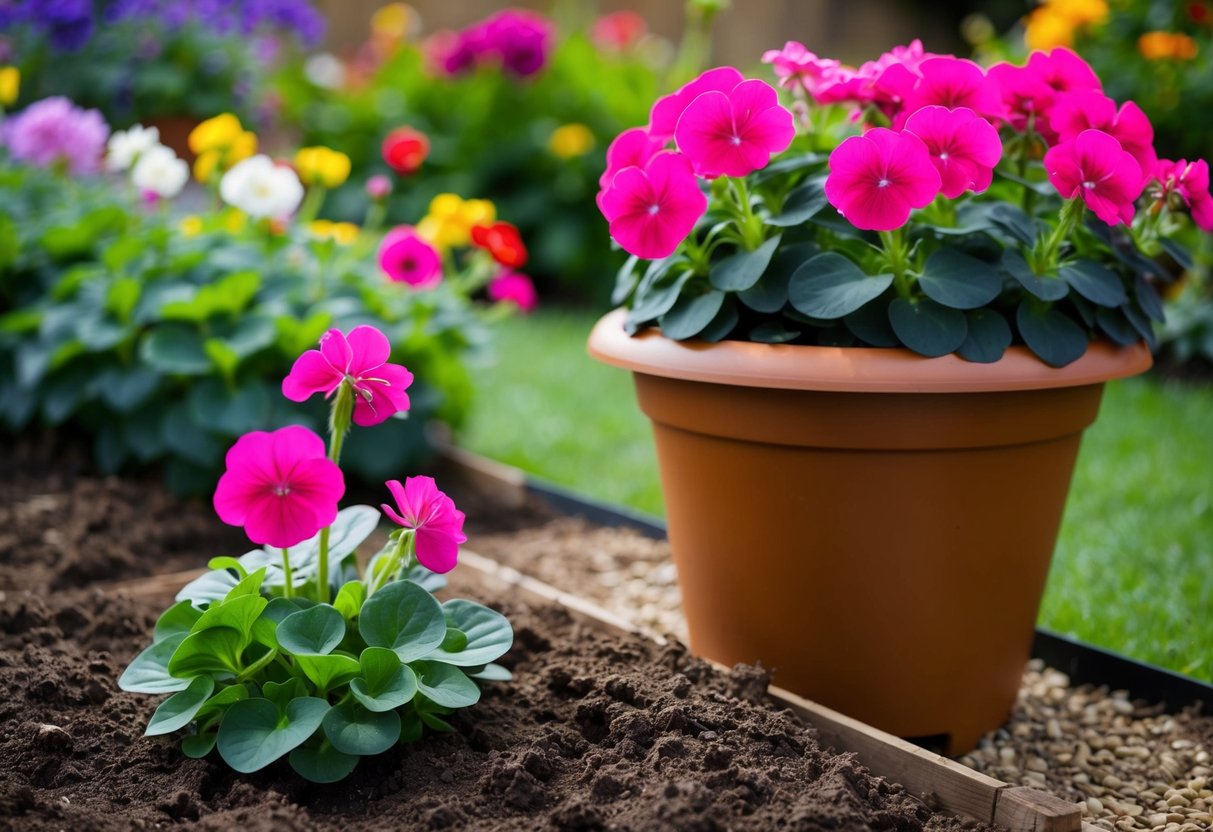Do Geraniums Do Better in Pots or in the Ground: Expert Tips
If you’re considering growing geraniums, you might wonder if they thrive more in pots or directly in the ground. With their vibrant blooms and easy care, geraniums are a popular choice for many gardeners. Geraniums can do well both in pots and in the ground, but their needs might differ based on your environment and goals.

Potted geraniums give you the flexibility to move them around, ensuring they get the perfect amount of sunlight. This is especially useful if you live in a region with fluctuating weather. Pots also offer you control over soil conditions and moisture levels.
Garden geraniums, on the other hand, can spread out more naturally in the ground, allowing for robust growth if your soil and climate are favorable. Keep reading to learn how to give your geraniums the best shot, whether in a pot or a garden bed.
Benefits of Potting vs. Garden Planting

Choosing between potting and planting in the ground for your geraniums can make a big difference in their growth and care. Each method has its perks, depending on your climate, care routine, and growing conditions.
Container Advantages
Potting geraniums in containers gives you flexibility. You can move the pots to get full sun all day, especially in cooler months. Containers also let you bring your plants inside if temperatures drop suddenly. This is helpful since geraniums can struggle in some USDA zones.
Containers are great if your garden soil isn’t ideal. They guarantee well-drained soil using quality potting mix and proper drainage holes. Plus, you can easily control the moisture levels, ensuring your geraniums stay healthy and vibrant.
In small spaces, a container garden can be a creative solution. Plant geraniums close together, as they often bloom better when slightly root-bound. This setup brightens up patios or balconies efficiently.
Ground Planting Benefits
Planting geraniums directly in garden beds allows them to develop strong roots. Once established, these plants require less frequent watering compared to those in pots, as the ground retains moisture better. This can save you time and effort during hot spells.
In regions with mild winters, geraniums in the ground can thrive, as they benefit from bigger growing spaces and natural resources. This method works best in USDA hardiness zones 8 to 11, where winters don’t threaten their survival.
Garden-grown geraniums have access to more nutrients naturally found in soil. These conditions can lead to robust growth and larger plants compared to their potted counterparts. With adequate care, such as occasional mulching for moisture retention, your garden beds can excel at keeping your geraniums healthy and blooming.
Selecting the Right Geranium Variety

Choosing the right geranium involves understanding the different types and their distinct care requirements. Each variety has its own characteristics, which can affect their growth and appearance.
Types of Geraniums
Geraniums come in many varieties, and selecting the right one depends on your needs. Zonal geraniums are popular for their large blooms and upright growth. These do well in full sun, making them perfect for sunny spots.
Scented geraniums, valued for their fragrant leaves, can thrive in both full sun and partial shade. If you prefer trailing plants, ivy geraniums are a great choice as they do well in hanging baskets and window boxes.
Hardy geraniums, sometimes known as cranesbills, are ideal for landscape planting. They are perennial, returning each year with minimal care. These types are suitable for garden beds and can handle afternoon shade. Meanwhile, pelargoniums are often treated as annuals in colder climates but can behave like perennials in mild regions. Considering these types will help you make the best choice for your garden or container space.
Geranium Care Requirements
Geranium care can vary based on the type you choose. For most geraniums, providing well-draining soil is essential. Pelargoniums prefer sunny locations and require regular watering. Make sure the soil is dry before watering to avoid overwatering.
Hardy geraniums are low-maintenance plants that thrive in various conditions. They need decent sun exposure but can also grow in partial shade. Fertilizing these geraniums every few weeks during the growing season will boost their growth.
Ivy geraniums need less sun and can tolerate more shade compared to other types. They appreciate consistent watering to ensure healthy foliage and blooms. Remember to deadhead spent flowers to encourage new growth. This basic geranium care ensures vibrant plants whether they’re in the ground or in pots.
Planting and Maintenance

Proper planting and maintenance of geraniums can lead to healthy growth and vibrant blooms. To achieve this, focus on soil and watering, pruning and fertilization, and effective propagation and overwintering techniques.
Soil and Watering Tips
Use a well-draining soil to prevent root rot. A mix of potting mix and compost works well. Flower beds should have well-draining soil.
Ensure pots have good drainage to avoid soggy soil.
Water when the top inch of soil is dry. Avoid overwatering to prevent root issues. Adjust watering based on outdoor conditions. Place potted geraniums in a location with adequate airflow to maintain optimal moisture levels. If geraniums become root-bound, consider repotting them in a larger container.
Geranium Pruning and Fertilization
Regular pruning is necessary to encourage new growth. Trim dead stems and deadhead spent flowers.
Geraniums are heavy feeders, so use a balanced fertilizer every four to six weeks during the growing season. This helps them maintain vibrant blooms and robust foliage. Be mindful of the amount, as too much can harm the plant.
Using products like neem oil can help manage pests naturally.
Propagation and Overwintering
Propagation is a useful way to expand your geranium collection. Cut healthy stems, around 4-6 inches long, and plant them in well-draining soil.
Starting geraniums from seed can be rewarding. For overwintering, bring geraniums indoors before the first frost.
Keep them in a cool, dry place with minimal watering to allow them to go dormant.
By spring, gradually reintroduce them to light and increase watering to stimulate new growth.
Potting Geraniums Successfully

Potting geraniums can lead to lush and long-lasting blooms when done correctly. Selecting the right pot and knowing how to pot and repot these plants ensures they thrive.
Choosing the Right Pot
When potting geraniums, selecting an appropriate pot is crucial. A pot with a diameter of 12 to 16 inches is often ideal. This size allows enough space for the root system without excess soil, which can stay too wet. Ensure the pot has plenty of drainage holes to prevent waterlogging, which can cause root rot.
Terracotta pots are often a great choice because they allow the soil to breathe. The porous nature of terracotta helps in maintaining slightly acidic soil pH, suitable for geraniums. Lightweight plastic pots can also work but consider adding a layer of pebbles at the bottom to enhance drainage. Remember, a well-drained pot encourages healthy and vibrant blooms.
Potting and Repotting
Begin with well-draining soil and make sure it’s slightly acidic, with a pH of 6.0 to 6.5. A good soil mix includes potting soil, perlite, and a bit of sand. When planting geraniums, press the soil gently around the base to secure the plant without compacting it.
Regular repotting every couple of years is beneficial. Choose early spring for repotting when new growth kicks in. Look for signs the plant needs repotting, such as roots growing out of the drainage holes. Transfer your geranium to a slightly larger pot, adding fresh soil. Refreshing the soil improves nutrient uptake, contributing to vibrant and long-lasting blooms.
Troubleshooting Common Problems

Geraniums can face several issues, but many can be solved with the right care and attention. You’ll need to watch out for pests and diseases that can affect your plant’s health.
Dealing with Pests and Diseases
Geraniums are sometimes bothered by pests like spider mites, geranium budworm, and mealybugs. These pests can cause damage by feeding on the plant’s leaves and flowers. You might notice fine webbing from spider mites or cottony white clusters on leaves from mealybugs.
To combat these pests, neem oil is a popular choice. This natural remedy not only kills pests but also prevents new infestations. Simply spray the oil on affected areas every few days until the pests are gone.
Diseases like mildew can also affect your geraniums. Mildew appears as a powdery substance on leaves and thrives in wet conditions. Ensure your plants have good airflow and water them at the base, avoiding getting the leaves wet.
By keeping a close eye on your geraniums and addressing problems early, you’ll help your plants stay vibrant and healthy.







